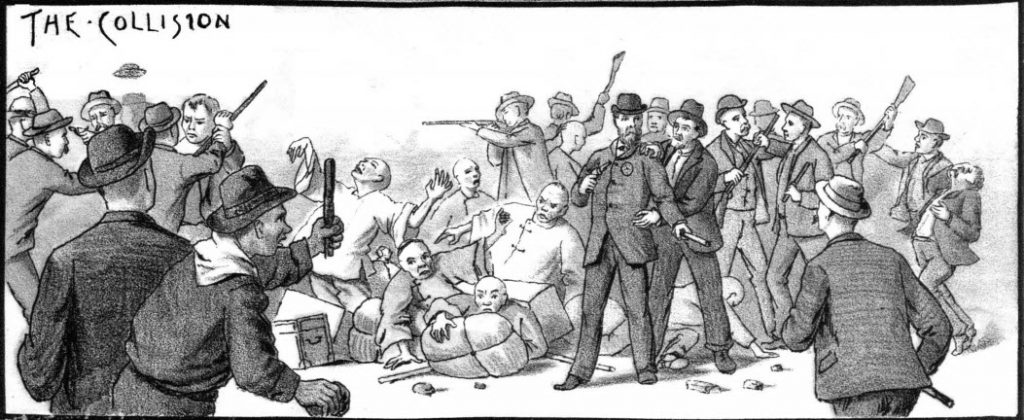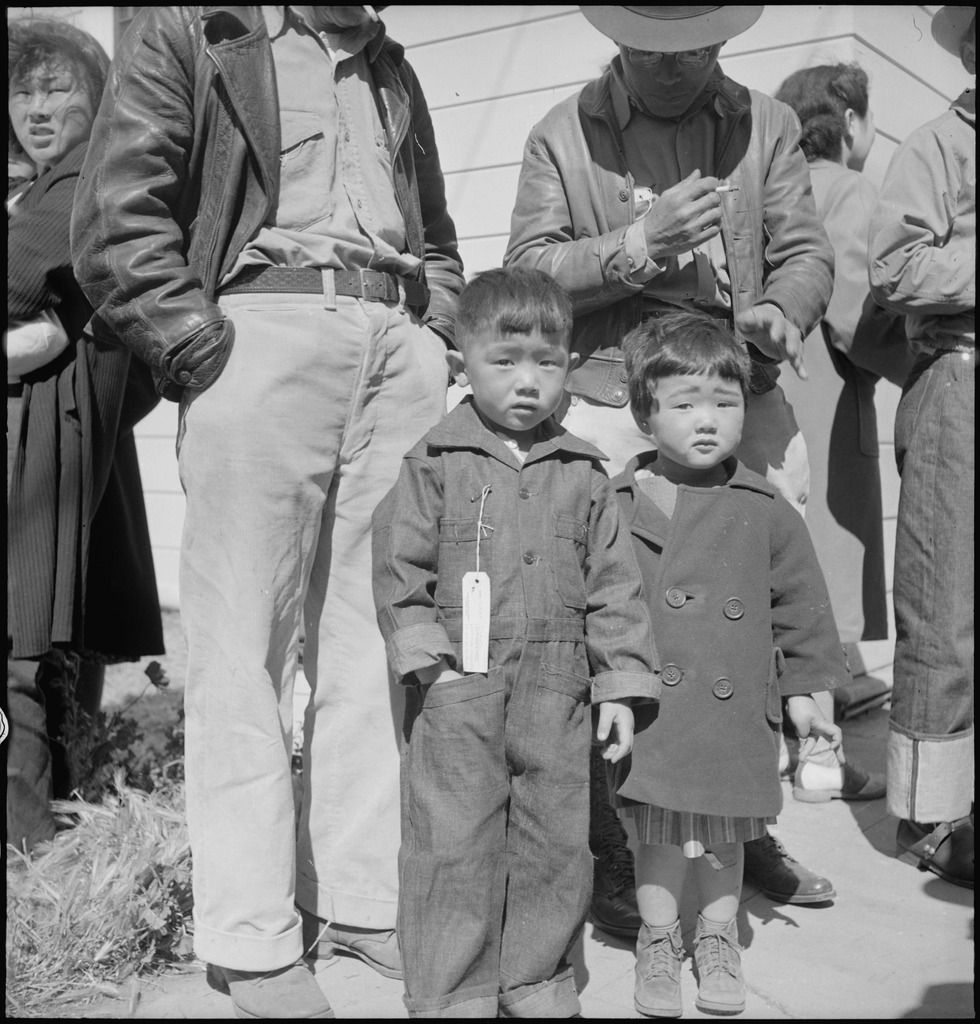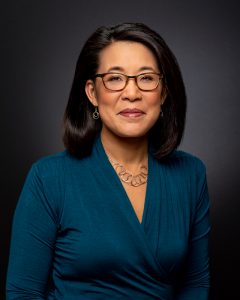March 22, 2021
In the wake of the heinous murders in Atlanta and a sharp uptick in anti-Asian hate crimes, Congress held its first hearings on discrimination against Asians in more than 30 years. Among those testifying was Erika Lee, a historian whose books on Asian America and xenophobia have brought deeper understanding to scores of readers (and provided the historical foundation for Densho’s own short film on xenophobia).
In a moment when the need for healing and education has been made painfully obvious, Dr. Lee delivered an incisive history lesson to our Congressional leaders — and she gave us permission to reprint her testimony in full here.
Testimony of Erika Lee, PhD, presented before the Subcommittee on Civil and Constitutional Rights Committee on the Judiciary on March 18, 2021
We are here because there has been an alarming rise in anti-Asian racism and violence over the past year. Beginning in late January of 2020, Asian Americans reported being harassed, yelled at, attacked, and shunned in stores and restaurants; on city streets, buses, and subways; and in their own neighborhoods. A new report recently released by the Center for the Study of Hate and Extremism at California State University, San Bernardino found that hate crimes targeting Asian people rose by nearly 150 percent in sixteen of America’s largest cities. It could be even higher. In 2018, the FBI’s hate crime statistics recorded 148 anti-Asian hate incidents. From March 2020 to the end of February 2021, Stop AAPI Hate recorded nearly 3,800 reports of racist incidents from all fifty states and the District of Columbia. This represents a 2,500 percent increase from previous years. In New York City, there was a staggering 2,600 percent increase in anti-Asian hate crimes.
These attacks have been happening throughout the pandemic, and there is no sign of them slowing down. One national survey found that sixty percent of Asian Americans reported that racism against them had increased during the pandemic. And racist attacks of Asians have continued across the country in 2021. This has included the case of a 91-year-old Asian man being shoved to the ground in Oakland’s Chinatown and the murder of an 84-year-old Thai American man in San Francisco in February.
As shocking as these incidents are, it is vital to understand that they are not random acts perpetrated by deranged individuals. They are an expression of our country’s long history of systemic racism and racial violence targeting Asian Americans and Pacific Islanders.
This history is over 150 years old. Let me share just a few examples:
- In 1871, seventeen Chinese immigrant men were lynched by a mob of 500 in Los Angeles; this was the largest mass lynching in U.S. history.
- On September 2, 1885, twenty-eight Chinese workers were massacred at Rock Springs, Wyoming, and the homes and bunkhouses of seventy-nine Chinese men were torched. The bodies of the dead were thrown into the fire; the wounded, unable to run, were also tossed onto the pyre.
- In 1885, a mob of five hundred armed white men forcibly expelled 700 Chinese residents from Tacoma, WA. They kicked down doors, dragged Chinese from their homes, pillaged their businesses and marched them out of town. Then they burned down Chinatown to the ground. A few months later, a mob of 1500 gathered to force all Chinese out of Seattle.
- In the summer and fall of 1906, local police recorded nearly 300 attacks on Japanese immigrants in San Francisco.
- In 1907, all South Asians in Bellingham, WA were forced out of their homes, dragged off streetcars, and forced out of town or into the city jail.
- In the 1920s, Filipinos were stabbed and beaten in Stockton, expelled from the Yakima Valley in Washington, attacked in Dinuba, Exeter, Modesto, Turlock, and Reedley, CA. In December 1929, a mob of 400 white men attacked a Filipino dance hall in Watsonville. Four days of rioting ensued, leaving many Filipinos beaten and one dead.
- In 1932, Native Hawaiian prizefighter Joseph Kahahawai was abducted, shot and killed by four white vigilantes after a white US navy wife falsely claimed that she had been raped by Kahahawai and other Native Hawaiian and Asian American men.
- During and after World War Two, Japanese Americans were victims of multiple acts of terrorism that included gunshots fired into their homes and businesses, arson fires, threats, and vandalism.

The 1980s represented another increase in anti-Asian racism. An economic recession, an increase in xenophobia, media stereotypes, and inflammatory anti-Asian language by government officials and business leaders relating to US trade tensions with Japan, resulted in violence.
- In 1982, Vincent Chin, a Chinese American, was beaten to death in Detroit because his attackers thought he was Japanese and blamed him for the economic decline in the auto industry. “It’s because of you motherfu–ers that we’re out of work,” they said.
- In 1987, a South Asian man was killed in Hoboken, New Jersey, and then another was severely beaten a few days later in Jersey City. Attackers called themselves “dotbusters,” a reference to the symbol worn by Hindu Indian women on their foreheads.
- Attacks on Asian Americans — ranging from Korean shopkeepers to Lao and Cambodian refugees were so many in 1987 that the Los Angeles Times published an article titled “Wave of Violence Against Asians Plagues the Nation.”
In the week and months after 9/11, hate crimes directed against Muslim, Middle Eastern, and South Asian Americans increased by 1,600 percent throughout the nation, according to the Federal Bureau of Investigation. These included murders, property damage, physical violence, and harassment.
- On September 15, 2001, Balbir Singh Sodhi, a Sikh gas station owner in Mesa, Arizona, was murdered by a self-proclaimed American “patriot” who blamed him for the terrorist attacks.
- In the eight weeks that followed 9/11, more than a thousand incidents of racial violence were reported, including nineteen murders, attacks on places of worship, and personal intimidation and harassment.4
- More than ten years after 9/11, Sikh Americans remained targets of extreme racial and religious violence, as seen in the shooting rampage at Oak Creek, Wisconsin, in August of 2012 that left six Sikh Americans dead and a responding police officer severely wounded.
As these incidents reveal, Asian Americans have been terrorized, treated as enemies, and discriminated against. Like African Americans and American Indians, Asian Americans were considered racially inferior and unfit for U.S. citizenship for most of our country’s history. They were denied equal rights, barred from becoming naturalized citizens, prohibited from owning or leasing land and marrying whites in some states, and subjected to social and residential segregation.
The government of this country has not just ignored this problem. It has been part of the problem. Throughout much of our history, Congress and other elected officials have promoted and legalized anti-Asian racism through its laws and its actions.
- •In 1882, Congress passed the Chinese Exclusion Act, the first federal law to single out an entire group for immigration exclusion based on race and class. Initially passed as a temporary measure to bar Chinese laborers; it prohibited Chinese immigrants from becoming naturalized citizens, made it harder for all Chinese, including American citizens of Chinese descent, to enter and reenter the country, until the law was repealed in 1943.
- By the 1930s, Japanese, Korean, South Asians, and Filipinos were also barred from entering the US and from becoming naturalized citizens. Asian immigration was not placed on equal footing with other immigrant groups until 1965.
- After President Franklin Delano Roosevelt signed Executive Order 9066 in February of 1942, the government initiated the forced relocation and mass incarceration of 120,000 Japanese Americans. Forced from their homes, they were sent to prison camps as “prisoners without trial” for the duration of the war. Two-thirds were American-born citizens.
- Beginning after 9/11 and for many years after, South Asian Americans faced systemic racism in the form of profiling and surveillance by various government agencies and officials.4
- During this past year, some of our highest elected officials deliberately and consistently used racist language tying COVID-19 to Asians. This included phrases like the “Chinese virus” and “Wuhan virus” and telling Americans to “blame China” for the pandemic.

This history is not often taught in our schools. Instead, many Americans believe the deceptive “model minority” stereotype portraying Asian Americans only as success stories. But these recent acts of anti-Asian violence show that Asian Americans and Pacific Islanders do indeed experience systemic racism and discrimination.
We need to acknowledge the seriousness of the crisis facing AAPIs today: “‘Alarming surge’ in anti-Asian violence across US terrifies community members,” reported The Guardian on February 20, 2021; “Anti-Asian hate crimes and harassment rise to historic levels during COVID-19 pandemic,” wrote the LA Times on March 5th. And from NBC News on March 10: “Racism Virus: Anti-Asian Attacks Surge.”
As the virus has spread across the country, so has anti-Asian racism. This violence follows the racist tradition that has defined the Asian American experience in the US: despite long histories and deep roots in America, Asian Americans are still viewed as racial others, outsiders, and foreigners; as enemies rather than citizens. Many perpetrators blame China and all Chinese-appearing people for the virus and its spread within the United States. “A man right outside of the main Massachusetts General Hospital entrance yelled at me, ‘Why are you Chinese people killing everyone? What is wrong with you? Why the f**k are you killing us?’” a victim reported from Boston. In Dickson City, Pennsylvania, another victim described an incident that occurred while walking to a supermarket. A “man yelled, ‘This pandemic wouldn’t have happened if you stayed in your country where you belong, you chink. You brought the virus on purpose.’”
The violence also stems from America’s longstanding practice of identifying foreigners — and those perceived to be foreign —with disease. On February 2, 2020, an Asian woman was attacked in the New York City subway station for wearing a mask. One witness said she heard a man call the woman, who appeared Asian, a “diseased bitch.” In Marietta, Georgia, a victim reported that she was in line at a pharmacy when she was attacked. “A woman approached me and sprayed Lysol all over me. She was yelling out, ‘You’re the infection. Go home. We don’t want you here!’”
Lastly, the anti-Asian violence also reflects the ways in which exceedingly diverse populations of people who can trace their roots to countries throughout East Asia, South Asia, and Southeast Asia have been lumped into one homogenous group and treated similarly. A majority of those who have reported hate incidents identified as Chinese and as female (70 percent). But Asian Americans who identified as many other ethnicities, including Korean, Vietnamese, Japanese, Thai, and Filipino, have also been victimized. Last March, 34-year-old Bawi Cung, originally from Burma, was grocery shopping at a Sam’s Club in Midland, Texas, when a man grabbed a knife from a nearby rack. Cung was slashed on his face, his 3-year-old was stabbed in the back, and his 6-year-old was stabbed in the face. In the suburbs outside of Minneapolis, a Hmong American family returned to their house to find a sign posted at their door: “We’re watching you,” the note said. “Take the Chinese virus back to China. We don’t want you here infecting us with your diseases.” It was signed, “Your friendly neighborhood.”
But what has happened in 2020 and 2021 has been more than just the logical culmination of America’s long history of racism. A confluence of factors have allowed anti-Asian racism to reach full force during the coronavirus pandemic: more than 500,000 lives lost, economic uncertainty and record unemployment, political division, and international turmoil.
But an equally important factor has been that some members of the media and some of our highest elected officials have deliberately and consistently used racist language tying COVID-19 to Asians. This has included phrases like the “Chinese virus” and “Wuhan virus” and telling Americans to “blame China” for the pandemic.
These words matter, especially when they repeatedly came from the White House during the previous administration. Researchers found that the anti-Chinese rhetoric promoted by leaders directly correlated with a rise in racist incidents against Asian Americans. President Trump, whose “Chinese virus” tweets were retweeted millions of times, was “the greatest spreader…of anti–Asian American rhetoric related to the pandemic,” they argued.
Anti-Asian violence has exacerbated the pandemic and disrupted and cost lives. But it is just one of the ways in which the pandemic has impacted Asian Americans. Numerous studies show how Black, Indigenous, Latinx, Asian Pacific American, and other peoples of color are at increased risk of COVID-19 infection and death. In San Francisco, Asian Americans made up 37 percent of all COVID-19 deaths, the most of any ethnicity.
Representing 8.5 percent of all essential healthcare workers, Asian American and Pacific Islander healthcare workers have also played outsized roles on the frontlines of the war against the virus. They are providing critical response and risking their lives to keep hospitals running and Americans healthy. More than 1 in 5 (or 195,000) physicians and surgeons are AAPI, and 1 in 7 (or 132,000) are specifically AAPI immigrants. In California, almost one-fifth of all registered nurses are Filipino. On the frontlines in hospitals and nursing homes, many of these nurses have underlying health conditions and tend to work in the ICU and acute care and surgical units where COVID-19 patents are treated. The toll has been devastating. Nearly a third of the nurses who have died of coronavirus in the US are Filipino, even though Filipino nurses make up just 4% of the nursing population nationwide.
Over 1.2 million AAPI workers are working in food-related industries nationwide at farms, food processing factories, grocery stores, and restaurants. They are helping to secure the U.S. food supply chain, but they are also placed at disproportionate risk of infection and mortality. At the same time, the unemployment rate for Asian Americans spiked by more than 450 percent in the first six months of the pandemic. In San Francisco and New York City, shuttered Chinatown businesses placed both low-income workers and residents at even greater economic risk.
Like all Americans, Asian Americans and Pacific Islanders are struggling with the public health crisis and the shuttered economy. That we also have to worry about being attacked or harassed in our own neighborhoods makes our pandemic experience even more difficult.

The acts of hate facing Asian Americans and Pacific Islanders today are a systemic national tragedy. They will not simply go away after the pandemic. Just as anti-Black racism is deeply rooted in our past, so is anti-Asian racism.
So, what can be done? What must be done?
The last time (and seemingly the only other time in our history) that Congress held hearings on anti-Asian racism was thirty-four years ago. In 1987, this committee, the Subcommittee on Civil and Constitutional Rights of the Judiciary Committee in the House of Representatives, met to address anti-Asian violence. Hon. Don Edwards, chairman of the subcommittee, opened the hearings by saying “We know far too little about anti-Asian prejudice and violence.” Thirty-four years later, we still know far too little. But it could not be clearer that Congress has failed to sufficiently address the enduring problem of anti-Asian racism in the United States.
Last year, Congresswomen Judy Chu (D-CA) and Grace Meng (D-NY), along with Senators Kamala D. Harris (D-CA), Tammy Duckworth (D-IL), and Mazie Hirono (D-HI) introduced House and Senate resolutions denouncing anti-Asian sentiment. House Resolution 908 – Condemning all forms of anti-Asian sentiment as related to COVID-19 passed on September 17, 2020. The Senate’s concurrent resolution 53 condemning all prejudice against individuals of Asian and Pacific Island ancestry in the United States also passed around the same time. During his first week in office, President Joseph R. Biden issued a memorandum condemning and combating racism, xenophobia, and intolerance against Asian Americans and Pacific Islanders in the United States. He recently denounced attacks against Asian Americans again.
These are all crucial actions. But they are not enough.
Over 20 million in number, Asian Americans are now the fastest growing racial group in the United States. We are your constituents. But we are in crisis from the multiple and disproportionate effects of the pandemic on our diverse AAPI communities.
Congress needs to act definitively and immediately to address the enduring problem of anti-Asian racism in the United States. We call upon our leaders to condemn racism in all of its forms, invest in AAPI communities, and support individuals who have experienced race-based violence.
We cannot afford to wait another thirty-four years for Congress to act.
—
Erika Lee is an award-winning historian and author, Regents Professor of History and Asian American Studies, and Director of the Immigration History Research Center at the University of Minnesota. The granddaughter of Chinese immigrants, Lee recently received a Carnegie Fellowship and was elected to the American Academy of Arts & Sciences. She is the author of four award-winning books including, most recently, The Making of Asian America and America for Americans: A History of Xenophobia in America, which won the American Book Award and the Asian/Pacific American Award for Literature, as well as other honors. It will be published with a new epilogue on xenophobia and racism during the COVID-19 pandemic in June, 2021. Lee has been featured in PBS’s film series “Asian Americans,” appeared on CNN, PBS Newshour, National Public Radio, and quoted in the New York Times, Washington Post, LA Times, BBC, and many other news outlets. She is Vice President of the Organization of American Historians and directs three major digital humanities projects: Immigrant Stories, #ImmigrationSyllabus, and Immigrants in COVID America.
[Header image: An altar filled with flowers at the Vigil for Atlanta Massage Workers hosted by the Seattle Massage Parlor Outreach Project on March 22, 2021. Photo by Nina Wallace.]

